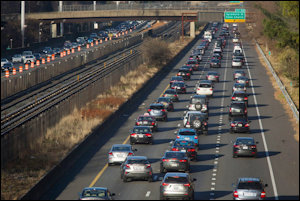When the Interstate 66 Express Lanes opened a year ago, they triggered a maelstrom of controversy as Northern Virginia commuters encountered new driving patterns. Motorists were particularly irate at peak rush-hour tolls rising as high as $47.50 to drive just a few miles on I-66 inside the Beltway. Virginia transportation officials said, never fear, people would adapt and the picture would improve.
So… Has it? The Washington Post has taken a close look at the numbers. And the newspaper’s verdict is: The express lanes have caused shifts in driving behavior — shifting more people to carpooling, more to mass transit — but for the most part commuters are as miserable as ever.
Some of the changes:
- Some drivers delay their commute, pushing “rush hour” to later in the morning.
- Some have started taking the Metro rail and bus systems, even as ridership has fallen regionally. Ridership at the West Falls Church and East Falls Church stations is up by about 200 riders on average, about 5%. Some bus routes have seen higher ridership as well, although the number of passengers is small.
- Some take alternative routes, displacing congestion to un-tolled arterials. Parallel roads have seen slight increases in traffic. There is plenty of anecdotal evidence that congestion on side roads has gotten worse, but state reports indicate that travel times have not increased notably.
- Because high-occupancy vehicles can ride the express lanes for free, more people are car pooling. The number of vehicles with two or more riders on I-66 inside the Beltway has increased by about 3,000.
Almost everyone hates the tolls but, judging from the numbers in the WaPo story, only a tiny fraction of Northern Virginians have changed their driving habits. A root problem seems to be commuters’ needs for flexibility. Commuters’ work hours and travel routes are unpredictable, so arranging carpools and hewing to mass transit routes and schedules is immensely inconvenient for most.
Bacon’s bottom line: There is no quick fix for Northern Virginia’s transportation challenges. Transportation arteries are fully built out for 20 to 40 miles from the Washington City Center, so it is cost prohibitive to acquire the rights of way for expanded highways and interstates. Meanwhile, the bulk of the region’s land use patterns remain hostile to pedestrian activity and mass transit. Change is occurring as major activity centers are retrofitted as walkable urbanism, but the process is painfully slow. Knitting together a coherent urban fabric from the scattered, disconnected, low-density sprawl literally takes decades, even generations. Hopefully, mega-projects like the Tysons retrofit and the Amazon headquarters expansion will accelerate the transformation in places.
Motorists are understandably resentful of the costs and frustrations associated with their commutes. In the grand American tradition, they want someone to “fix” the problem — as long as someone else pays for the fix. Until the region evolves land use patterns that better jobs/housing/amenities balance that reduces the need for so much long-distance driving, however, no amount of money can make commutes materially better. Like death and taxes, traffic congestion appears to be part of Northern Virginia’s existential condition.



